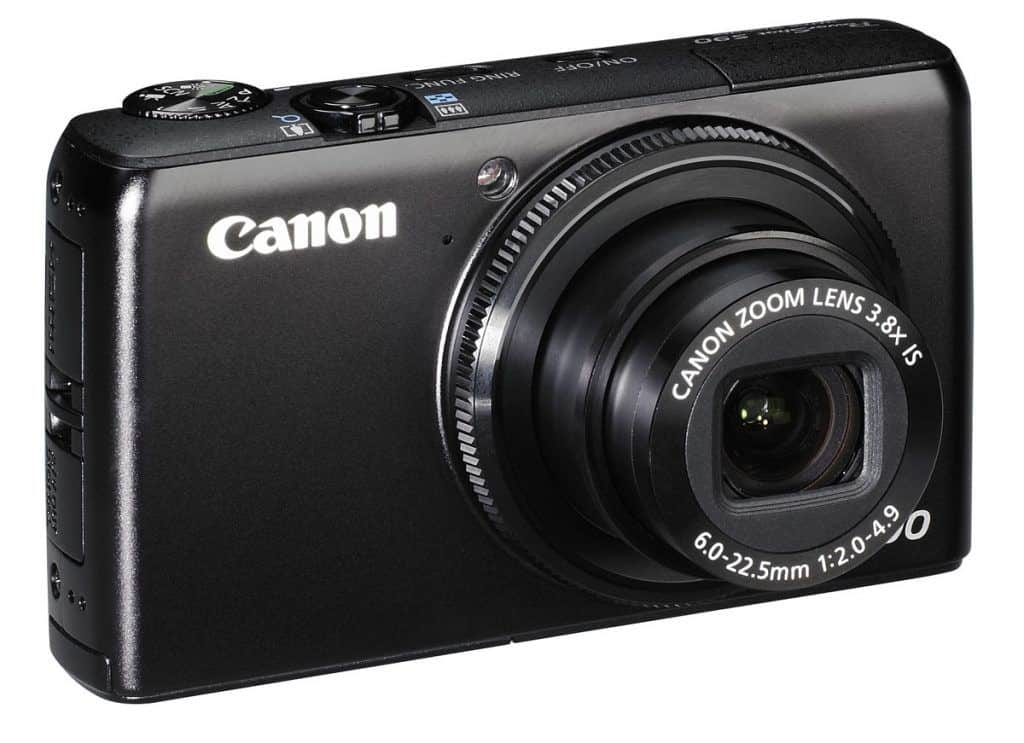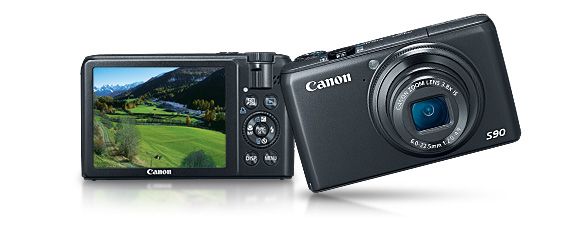Table of Contents
amazon Canon S90 reviews
Canon has announced the revival of the S-series high-end travel camera with the Canon PowerShot S90. Owning the fashionable design inspired by the “Canon IXUS 120 IS” junior, along with a host of cutting-edge features and above all, superior image quality, the product promises to meet the needs of everyone. Launched at the same time as the “Powershot G11” model, the S90 represents the ambition of Canon to recapture the high-end compact camera market that is dominated by Sony and Panasonic.
Unlike the “big brother” G11 with a rough appearance, Powershot S90 looks pretty eye-catching in the slim design and elegant black. The machine is three-dimensional 100 x 58 x 31 mm and weighs 195 grams including battery, smaller and lighter than the competitor’s Panasonic LX3 (109 x 59.5 x 27 mm and 265 grams). The front of the S90 is quite flat with some simple straight edge curves like the recently released IXUS, such as the IXUS 100 IS and the 120 IS. The top side has a “Ring Func” button, which provides quick access to the lens control ring. The rear joystick system is similar to the Canon travel models so users do not take too much time to get used to the G11 version. In addition, the company also equips S90 a revolving circle of four navigation keys. This rotation helps to quickly change some parameters of the shooting process such as brightness compensation, focus range (in manual mode) or scene selection, menu scrolling and image browsing. The S (Shortcut button) not only launches photo printing but also helps users set up one of 12 features supported by the machine.
The right side of the S90 has a flash pop up. Rather than springing up the mechanical spring as some Canon models, the lamp is controlled by an electronic motor inside. You also can not push it back to the place directly by hand. Flash control operations must be performed entirely by the on-screen display menu. Many people will enjoy watching the S90’s flash pop up and get pretty fast from the edge with just a click of a button.
The screen size is 3 inches, resolution 460,000 pixels, twice as high as most popular travel machines today. With PureColor LCD II technology, this monitor has the ability to display true colors even in bright light. However, the machine does not own optical viewfinder and flip screen rotation features like “brother” G11. The interface of the machine is relatively simple, so it is easy to familiarize. Customizations can be made fast with the flexible help of two control loops, one on the lens body and one on the navigation pad.
The lens on the S90 has a focal length of 28-135 mm on the film. Compared to its predecessor, the Panasonic LX3, which owns a 24-60mm lens, the S90 gives users more flexibility in image composition. With the addition of two aspherical lens elements, the camera’s aperture can be extended to f / 2.0, equivalent to the “Leica Vario-Summicron” on the LX3. Combined with Canon’s renowned optical image stabilizer technology, the S90 can produce ideal shots in severe dark conditions without the need for a tripod. High-precision test shows that the S90’s built-in lenses for sharpness and vignetting resistance appear in contrast areas as high as the G11, and are even better than kit tubes. The EF-S 18-55 mm IS is mounted on the Canon EOS 450D body.
The control ring controls the zoom function quite nicely. However, unlike SLR lenses that are capable of changing the focus, the S90’s lens is only available in 28mm, 35mm, 50mm, 85mm and 105mm (3.8x) increments. In addition, the adjustment ring also helps to change many other settings such as brightness compensation, ISO, shutter speed, aperture and focus range.
where can you get a Canon S90 online
Canon PowerShot S90 10MP Digital Camera with 3.8x Wide Angle Optical Image Stabilized Zoom and 3-Inch LCD (OLD MODEL): Buy it now
Canon DigitalCamera Power Shot S90 PSS90: Buy it now
The CCD sensor on the S90 is exactly the same as the high-end G11 with 10.1 effective megapixel resolution and 1 / 1.7 inch size. It can also burn RAW images up to 13 MB in size for each image type. If you save the file as a JPEG compressed file, the number is reduced to about 2.5 MB. Note, currently only two Canon compact cameras save files as raw images are G11 and SX1 IS. The sensor size is large while the megapixel is not so high that the size of each pixel is forced to increase. This means a significant improvement in the ability to reproduce color and noise reduction.
The ISO range of the machine varies from 80-3200. In low light mode, ISO can be up to 12,800, but the resolution is 2.5 megapixels. Canon’s Dual Noise Reduction technology makes it possible to achieve good results in low light conditions, noise can only be seen with ISO up to 800 – impressive with a compact model like the S90. Possessing the same sensor and processing algorithms on the same DIGIC 4 chip, the test images of the S90 and G11 are almost identical. The G11 has a slightly fresher and slightly brighter image due to the use of more advanced S90 lenses. However, you can rest assured that this difference is negligible even when viewing the image in full screen mode. At high ISO settings above 800, the noise canceling technology of the S90 and G11 tends to make the picture smooth and make the details lose. Meanwhile, the image of the Lumix LX3 is very messy and dull but retains more detail.
The speed of performance of the S90 is the most disappointing in this version of high-end travel camera. The product can only capture 0.9 frames per second when focus is set and reduced to 0.6 frames per second if the autofocus. Obviously, this speed is less than G11 with 1.1 frames per second and LX3 at 2.5 frames per second. Even in low light mode with a resolution of only 2.5 million pixels, the speed of the S90 is still only flicker at 2.1 frames per second. Meanwhile, the LX3 did the same thing with an impressive 6 frames per second.
Similar to the “G11”, the Powershot S90 also has video capture capabilities up to 640 x 480 pixels, a speed of 30 frames per second. The camera does not allow the use of optical zoom during movie recording. The Lithium battery allows about 220 shots to be charged, which is slightly lower than the average.



I like the helpful information you provide in your articles.
I will bookmark your weblog and check again here frequently.
I’m quite certain I will learn lots of new stuff right here!
Best of luck for the next!